

In 1944, Florence is gearing up to protect its many monuments after a series of sad events. When the doors of the baptistery were removed in order to protect them from bombing, an inscription—or rather, a “strambotto,” a brief poem of popular origin—was discovered behind the bronze framework. It read, “The year one thousand three-eightdeds the Guelphs Ghibellini Fer’s war above the Pisan by sea and on the ground.” Livar the shackles of his from the harbor. Along with them is the admiral Fue Messer Perin Grimaldi Genovese, who is in charge of the nation and the port of Pisan. And in the sixty-four that followed, we were vanquished, and forty-two Carrate arrived here with our brigade. All of this relates to an old question over the city of Pisa that was “suspended” for numerous centuries.
The Florentine Republic received two columns of Pisans, sometimes known as the Balearics or Pisans, in 1117 as payment for the Pisans’ military assistance in defending the city of Pisa against Saracen pirates. The two incredibly clear porphyry columns (which, according to legend, should have reflected the faces of the acquitted criminals) that were brought to Florence as war booty from Menorca had turned dark due to the Pisans’ refusal to part with such a significant inheritance, which resulted in their irreparably destroyed and thus unusable columns (hence the proverb: “Blind Florentines and traitors”). The ups and downs between the two towns caused Florence to experience a string of victories, first achieved by Ridolfo da Varano and then by Ventura Bonifacio Lupi, the commander of Ventura. In order to show off its naval might, Florence hired Genoese galleys, who went on to capture several coastal regions and eventually the port of Pisan. The shackles intended to obstruct ships at the port’s entrance were broken and transported to Florence, where they were suspended from the two columns of the mocking Pisan statue that had degraded the Florentine people.
Some of the chain was strung as a battle trophy to serve as a warning to anybody who would approach the city’s entrances at Porta S. Frediano, which leads to the lawn, and Porta Romana, and also as a war trophy to a warning for anyone who wanted to get against the city of Florence. “I keep a letter of the Pisans to the reformations in which among the reasons for having the second time taken away from the obedience of the Florentine Republic, these chains will be atduconsi that By keeping up thus exposed, it seemed that it was a continuous deriding them and burning of their ancient misadventures…,” the historian Richa writes. This indicates that the Pisan city did not appreciate the fact that these trophies were on display. On April 11, 1424, the city of Florence was plagued by torrential rain, which caused Piazza S. Giovanni to overflow and involved the porphyry columns that were weighted down by the port of Pisa’s chains and broke apart in several locations. And it explains the rings that surround them today … but what happened to the chains? In 1848, despite centuries of rivalry between the two Tuscan cities, the Municipality of Florence was delighted to receive the chain back as a gesture of friendship from Pisa. This was the year of the spring of peoples, the year of revolutionary movements throughout Italy against absolutist regimes, and a new sense of brotherhood but above all of belonging to a unique nation pervaded the soul of the Italian peninsula. They are currently situated beneath the Monumental Camposanto of Pisa’s loggia. Curiously, in addition to the shackles that were brought back from Florence, there are also the chains that were taken from Genoa during the well-known Meloria war against the Pisans. Genoa was acquired by the Sardinian holdings from the Pisans who gave up Corsica, in San Giovanni d’Acri and committed themselves to paying a huge allowance to guarantee the Elba.
However, they failed or refused to honor the agreements, thus on August 23, 1290, the Genoese fleet under Corrado Doria set out once more to assault the rival city. The anonymous Pisan claims that upon arriving at Porto Pisano, the Genoese discovered him protected by a pair of towering structures that “had the towers of the dysiece, and disfigured the whole port, and Portonnone Genovese and the Lucchesi the chains of the doors.” It was tended to by Carlo Noceti, a Portoria native who started off making fires beneath their massive iron shirts so that when they become incandescent, it would be simpler to shatter them. Because of the blacksmith’s clever suggestion, they were able to reach the port of Pisa and make complete infertility and unusability of the land by rareling it and sprinkling it with salt (at that time, it was used in this way, so that even a thread of grass no longer grew, as the Romans had done with Carthage). Only in 1860, after their return from Genoa, did the chains return to Pisa bearing witness to the newly established Italian monarchy and the Italian towns’ fraternity. If You want know more about Florence and its History come with us we are running Florence Free Tour from Santa Maria Novella square, meting point in front of Minerva Hotel



